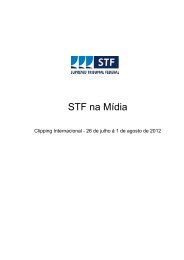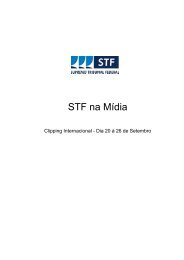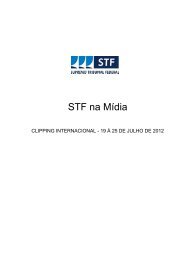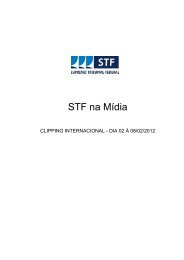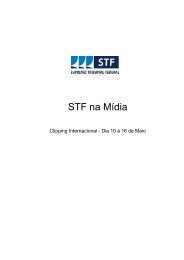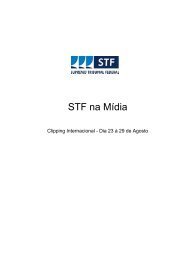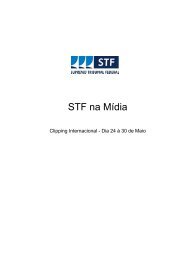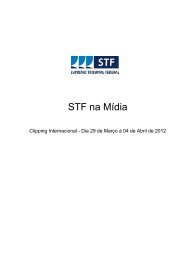STF na MÃdia - MyClipp
STF na MÃdia - MyClipp
STF na MÃdia - MyClipp
Create successful ePaper yourself
Turn your PDF publications into a flip-book with our unique Google optimized e-Paper software.
Los Angeles Times/ - Politics, Dom, 15 de Abril de 2012<br />
CLIPPING INTERNACIONAL (Civil Rights)<br />
When time allows, 1992 riots are<br />
poig<strong>na</strong>nt lesson in L.A. schools<br />
They were not even born at the time their city erupted<br />
in flames, violence and rage against a system that<br />
would not convict Los Angeles police officers of<br />
brutally beating a black man.But high school students<br />
Jiaya Ingram, Ashley Torres and Jessica Maldo<strong>na</strong>do<br />
have been gripped by accounts of the 1992 Los<br />
Angeles riots as they learn about them through poetry<br />
and plays, readings and recollections of their parents<br />
and others.They say they felt shock over police<br />
actions, horror over the mob violence and an uneasy<br />
feeling that it could happen again, particularly as<br />
u<strong>na</strong>rmed African Americans are killed, most recently in<br />
Florida, Oklahoma and Pasade<strong>na</strong>. Yet these<br />
tee<strong>na</strong>gers also express hope that they can make a<br />
difference through perso<strong>na</strong>l action - education about<br />
stereotypes, for instance, or peaceful protests. "I've<br />
learned that you have to be the change you want to<br />
see in the world," said Jessica, a junior at the Social<br />
Justice Leadership Academy, a small school at the<br />
Torres High School campus in East Los Angeles.<br />
"History is not wars and dates; it's about the choices<br />
you make."But two decades after the riots sparked<br />
massive violence that would leave dozens dead and<br />
thousands injured, lessons about them appear to be<br />
limited in Southern California classrooms. For many<br />
teachers, the pressure to teach content that will be<br />
tested in state standardized tests and Advanced<br />
Placement exams next month has crowded out time<br />
for the riots, however crucial they are to city history<br />
and the <strong>na</strong>tion's larger civil rights struggle.The Los<br />
Angeles Unified School District has not formally<br />
included the riots in its history curriculum because it is<br />
not part of the California social studies standards. The<br />
district plans to post material on its website for optio<strong>na</strong>l<br />
teacher use, however.Michael Reed, the district's<br />
history specialist, said the push to raise test scores<br />
has made principals "hawkish" about directing<br />
teachers to focus on the areas that will be tested. Test<br />
questions from the state's eighth- and 11th-grade U.S.<br />
history exams released by state officials don't stretch<br />
beyond the 1960s, although Reed said the latest tests<br />
included a question from the Nixon era of the 1970s."If<br />
students are taught what they will be held responsible<br />
for on tests, they do much better," he said. "I<br />
remember teachers who would close their doors and<br />
teach whatever their pet era was. It's fine, but<br />
California test scores go down the drain."At King Drew<br />
Medical Magnet High School, teachers focus on the<br />
1965 Watts riots because the school was founded in<br />
part to prepare students for medical and scientific<br />
careers, a community need at the time. The school<br />
does not expect to cover the 1992 riots because of<br />
time constraints, according to Karl Graeber, the social<br />
studies department chairman.Carson High School<br />
teacher Merri Weir also feels those pressures. But she<br />
ma<strong>na</strong>ges to squeeze the riots into her U.S. history<br />
section on the move to the suburbs, exploring how<br />
redlining created the kind of ethnic ghetto that<br />
exploded after Simi Valley jurors chose not to convict<br />
four Los Angeles police officers in the beating of<br />
Rodney King. Her students create a memorial about<br />
the riots - one pair of students, for instance,<br />
constructed one from burned plywood to symbolize the<br />
vast destruction the violence caused."The riots and<br />
1992 feel like a time period we can never get to<br />
because there are just not enough hours in the day,"<br />
she said. "But it's really important for my students to<br />
learn about what happens when a community breaks<br />
down or has no hope and no sense of<br />
justice."Teachers who work at private, charter, magnet<br />
or other nontraditio<strong>na</strong>l campuses may have more<br />
flexibility.Dorsey High School teacher Do<strong>na</strong>ld<br />
Singleton, for instance, is able to cover the riots as part<br />
of the school's law magnet program. In his introduction<br />
to law class, he explores the King case as part of an<br />
exami<strong>na</strong>tion of civil rights and related U.S.<br />
constitutio<strong>na</strong>l amendments.Ninth-graders at<br />
Gertz-Ressler High School, a charter campus, are<br />
creating multimedia poetry and photography<br />
presentations about the riots in Crystal Greene's<br />
elective English and math class.Greene, like many<br />
teachers, uses materials from Facing History and<br />
Ourselves, an inter<strong>na</strong>tio<strong>na</strong>l educatio<strong>na</strong>l organization<br />
that has trained more than 1,700 Los Angeles-area<br />
teachers in the last 17 years on how to teach about<br />
tolerance through case studies of the Holocaust, the<br />
Armenian genocide, the L.A. riots and the eugenics<br />
movement. The group, started in 1976, aims to present<br />
history not as an inevitable chain of events but as a<br />
series of choices by ordi<strong>na</strong>ry people that can produce<br />
great evil or tremendous good, according to Mary<br />
Hendra, the associate program director.The group's<br />
curriculum is used at such schools as St. John<br />
Chrysostom School in Inglewood. Through an<br />
assignment to interview their parents about the event,<br />
13-year-old Nahom Seifu learned for the first time that<br />
his mother was caught in the streets with no<br />
transportation and survived the violence only because<br />
a stranger invited her to spend the night at her<br />
home.At Crossroads School for Arts & Sciences in<br />
117



